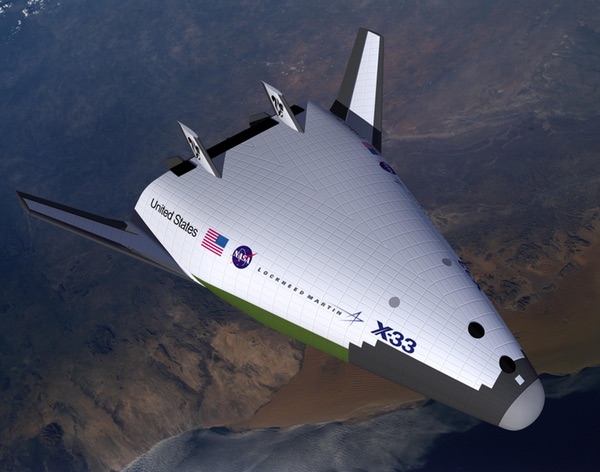Spaceplanes: the triumph of hope over experienceby John Hollaway
|
| A new fuel, a neat piece of technology, a novel material: they were always there to be venerated by scientists and financiers alike as the one great innovation that would make the whole business of going into space just a matter of boarding a spaceplane. |
Why not? Why can’t a single-stage-to-orbit spaceplane be constructed that flies up and then glides back to a soft landing? Or, more interestingly, why did rocket engineers all over the world never stop trying to build one, despite unending failures, awesome financial losses, and the brutal tyranny of the rocket equation, the one that makes multiple-stage rocket launches apparently unavoidable?
A major reason, certainly, is that the prize has always seemed so close. A new fuel, a neat piece of technology, a novel material: they were always there to be venerated by scientists and financiers alike as the one great innovation that would make the whole business of going into space just a matter of boarding a spaceplane. Currently, it seems to be spaceplanes air-launched from between two conjoined conventional aircraft; fingers crossed.
And, indeed, the Holy Grail is very close. If you had a conventional rocket exhaust of, say, 2,800 meters a second and you needed to get your rocket to low Earth orbit at 8,000 meters a second, then you would have a maximum of about four percent of the total weight of the rocket that you can devote to the structure, the engine, and the payload. But if you can speed up the exhaust gases to, say, 4,000 meters a second then this miserable fraction increases to more than ten percent—and you are in with a chance. This seductive calculation has drawn many to their doom, all going down protesting that they needed just a little more time, a little more money.
It is unfair to drag it up again, but Lockheed Martin’s X-33 VentureStar was a good example. It was initially a one-third-scale suborbital spaceplane developed in the 1990s and funded by NASA, one that can trace its roots to the earlier X-20 and X-30 spaceplane attempts. But X-33 would not have wings: it would save weight by using lifting body aerodynamics. It would also use liquid hydrogen, that most powerful of fuels, fed from unique lightweight cryogenic fuel tanks, it would employ a special lightweight metallic thermal protection system and use an “aerospike” combustion configuration said to be 15 percent more efficient that one using a conventional nozzle. Together, these innovations would surely defeat the evil equation, and at a relatively low cost.
No. In what appears to be another instance of administrative rigidity overruling engineering practicality, the failure of its innovative fuel tank during testing caused much rancor, and ultimately led to the withdrawal of federal support for the program in early 2001, after five years of work and the expenditure of $1.5 billion. Eventually, NASA pressed ahead with its great big conventional SLS rocket, a $10 billion-plus contribution to space launch, if not to its technology. No more risky stuff. Indeed, no more challenging, embarrassing itty-bitty spaceplanes.
| But the whole launch business is already in a dreadful case. Ever since World War II it has used the same basics to get to space; from the outside at least the V-2 engine looks little different from Blue Origin’s BE-4. |
I am not an American, but it grieves me to see the US shuffling towards this great boondoggle. The nation needs to acknowledge the fact that access to space has moved into the hands of competing private companies, that the government should get out of the commercial space business and settle down to regulating it. There are already dreamers aplenty out there who will make the bad decisions and lose the money that are intrinsic to eventual success in the real world. If they want to go to Mars, don’t stand in their way. And don’t go into competition with them.
NASA, 60 years on, has been overtaken by events. By its governmental nature it cannot make quick, or even its own, decisions, and in the new competitive environment it has become, through no fault of its own, dysfunctional and largely irrelevant. It still has utility as the government’s agency for enabling the industry, and perhaps to quietly nurture some of the wilder ideas, leaving the more sober ones for the space business to follow up. But why build and launch unwanted mega-rockets using a technology that is 70 years old?
But the whole launch business is already in a dreadful case. Ever since World War II it has used the same basics to get to space; from the outside at least the V-2 engine looks little different from Blue Origin’s BE-4. Although SpaceX and Blue Origin have demonstrated the reusability of the first stages (at a significant cost in reduced payload), the upper stages present major and expensive reusability challenges and are unlikely to be recycled.
In fact, the excitement over these developments has obscured the reality that they actually mark the limits of the space launch industry that we have known since 1945. As Churchill might have said, it is the end of the beginning. No doubt there will be more additions to the Wikipedia list in future, but it is certainly time to think about what comes next.
Note: we are temporarily moderating all comments subcommitted to deal with a surge in spam.
